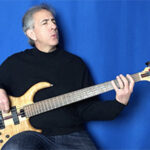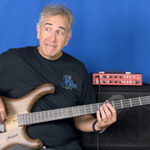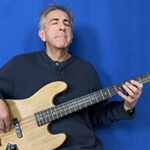I bet you never tried doing it this way!
By Jon Liebman
June 16, 2023
How long have you been “meaning” to get your sight reading together?
I remember, waaay back in the day, how frustrating it felt when I wanted to play something. I’d put the music on the stand and tried to decipher what in the world I was looking at.
It felt like it took forever just to get through just a few bars. And even longer to make it sound like real music.
Sound familiar?
The subject came up during a great conversation I was having with super bassist Al Caldwell, who just stepped down from a 26-year stint as bassist for Vanessa Williams.
I was telling Al all about the people who come to the Bottom Line Club to learn bass and how a lot of them struggle with their sight reading.
Al could totally relate. He sees a lot of the same frustration with his own students. “They got 8 Foderas, great basses,” he says, “and they want a teacher who doesn’t make them feel embarrassed about, ‘Hey, can you help me read?’”
So if you’re still grappling with learning to read music, take comfort in knowing you’re not alone. And that there’s a solution to your problem.
One bite at a time
“Instead of getting hooked on tons of passages,” Al continues, “we just do two measures at a time. But we really get into those two measures.”
Taking on anything in bite-sized chunks makes a lot of sense, especially with music. It takes away a lot of the overwhelming feeling you can feel from staring at all those little black dots.
You’ve got to start somewhere, so why not start by taking on one note at a time.
What goes up…
“I have a little secret that I make all students do, who don’t know how to read,” Al says, “especially the older ones. I say, ‘Say A-B-C-D-E-F-G.’ And then they do that, because they can say it comfortably.”
So far, so good, Al. What’s the big secret?
“(Then) I say, ‘Say G-F-E-D-C-B-A. Say it backwards.’ And everybody goes, ‘Huhhhh?’”
I’ve heard the expression about learning something till you know it backwards and forwards. I just never took it literally.
“If you can’t say it descending, how are you going to read it descending?” Al says, laughing.
The beauty is in the phrasing
After that, he has them take it up a notch.
“And then I make them go fast,” he says. “I make them challenge their friends. The faster they get, the more they enjoy the recognition.”
Why does it work? How does reading music backwards make someone a better sight reader and a better bass player?
“The beauty is in the phrasing,” says Al. “The beauty is in the note length.”
In other words, learning to read better can help you learn to play better. Al’s got an interesting approach and, to tell you the truth, I never looked at it that way. Try it.
Bottom line
Generally, there’s a lot of benefit to looking at the big picture to get some perspective on what you’re trying to do. Once you have that in mind, zero in on the small portions, taking on one short passage at a time, even if it’s just one measure.
Don’t tell yourself, “Oh, but there’s so much more.” Instead of going for perfection right out of the gate, strive for steady, incremental progress. Learning slowly, little by little, is better than not learning at all.
Once you start dissecting the small chunks, the light will start to go on and you’ll find similar configurations in the upcoming sections. There are only so many ways you can divide up a measure.
Look at it in as many ways as you can and you’ll see things start to click. The important thing is to get started.
Even if that means reading it backwards.
How about you?
Want to become a better sight reader? What techniques have you tried? Leave a comment below and share your experience.
If you need some help, my lessons and courses in the Bottom Line Club have not only solved sight reading problems for thousands of people, but also shown them how to develop good bass technique and learn to groove in their favorite styles. It’s a fast-growing community of bass enthusiasts. You really should be a part of it. Join the Bottom Line Club here.






WOW!!!!!! I knew Al was an amazingly accomplished bassist, but he’s an incredible instructor!!!! I HAVE NEVER HEARD ANYONE USE THE ANALOGY HE DID REGARDING READING MUSIC!!!!!! MIND BLOWN!!!!!!!
Mind blowing, indeed. Thanks, Keith!
Learned to read music when I was 24 years old. Now I’m almost 70 and its hard to start again to read notation for bass as fast as I want but it’s possible. Thanks for your support Jon.
You have all my support and encouragement. Keep at it, Jos. You can do this!
Sorry but I don’t see the point in trying to read music backwards – that doesn’t make any sense to me – you don’t learn to read a book by moving backwards saying the letters one at a time. You’ve got to connect it to actual playing music and music always moves forward whether it’s ascending or descending. Over time I’ve learnt to recognise the notes on the stave and see the intervals e.g. so I can see if it’s an arpeggio or scale part or octaves etc. – what I can’t do well yet is read the notes and instantly play them on the bass (I have to think about it too long) but hopefully this will come with practice, though I’ve got a bit too lazy depending on the tab.
For me learning to read rhythm is the biggest part of sight reading. If you get a measure that’s full of different combinations of 16th notes, 8th notes, triplets and with rests, that takes a lot of practice to read it and play it correctly. Then there’s the articulations, the staccato notes, the hammer-ons, pull-offs, slide etc – all this is part of sight reading. I used to find ties over the bar line and syncopation tricky but I’m getting better now. I usually practice by breaking it down into smaller sections or phrases which I loop over and over until I get it right and I actually need to be reading the music to learn it (I can’t just do it by ear) – I think muscle memory has a part to play in this as well. What I’d really like to be able to do is sight sing the music e.g. singing the melody or just recognising the intervals and being able to sing them from a starter note (like when you sing a scale do-ray-me-so-fa-la-te-do) and then to be able to play it on the bass and your fingers just go to the right note without you even having to think about what note it is, that would be the ultimate – some musicians can get a tune in their head and be able to play it spontaneously and even write it down – being able to write music as well as read it is a goal for me.
Good points, Celia. Yes, it’s a bizarre concept for sure. For me, the biggest takeaway is that we constantly have to try new ways to learn things. Some stuff works better than others and, as individuals, we have to find what works for us. I just thought it was an interesting way of looking at it.
For me, sometimes, after I’d gone over a piece, I would practice it by playing the last bar, then the last two bars, then the last three bars, etc. Technically, that’s not truly backwards in the way Al described it, but it oftentimes got my out of a rut of going over the music in the same way, over and over again. Maybe you’d like to give that a try! 🙂 If you do, let me know how it works out.
Thanks, as always, for weighing in.